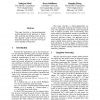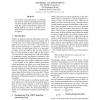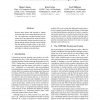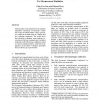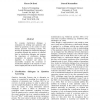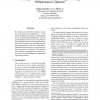NAACL
2003
14 years 1 months ago
2003
This paper describes a domain-independent, machine-learning based approach to temporally anchoring and ordering events in news. The approach achieves 84.6% accuracy in temporally ...
NAACL
2003
14 years 1 months ago
2003
NAACL
2003
14 years 1 months ago
2003
We describe initial experiments in combining the output of question answering systems using data from the 2002 TREC Question Answering task. We explore several distance-based comb...
NAACL
2003
14 years 1 months ago
2003
Sources of training data suitable for language modeling of conversational speech are limited. In this paper, we show how training data can be supplemented with text from the web �...
NAACL
2003
14 years 1 months ago
2003
Human tutors detect and respond to student emotional states, but current machine tutors do not. Our preliminary machine learning experiments involving transcription, emotion annot...
NAACL
2003
14 years 1 months ago
2003
Following the recent adoption by the machine translation community of automatic evaluation using the BLEU/NIST scoring process, we conduct an in-depth study of a similar idea for ...
NAACL
2003
14 years 1 months ago
2003
We examine clarification dialogue, a mechanism for refining user questions with follow-up questions, in the context of open domain Question Answering systems. We develop an algori...
NAACL
2003
14 years 1 months ago
2003
We present a syntax-based constraint for word alignment, known as the cohesion constraint. It requires disjoint English phrases to be mapped to non-overlapping intervals in the Fr...
NAACL
2003
14 years 1 months ago
2003
We introduce factored language models (FLMs) and generalized parallel backoff (GPB). An FLM represents words as bundles of features (e.g., morphological classes, stems, data-drive...
NAACL
2003
14 years 1 months ago
2003
We address the text-to-text generation problem of sentence-level paraphrasing — a phenomenon distinct from and more difficult than word- or phrase-level paraphrasing. Our appro...
